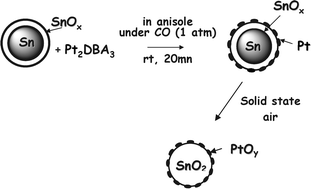Organometallic approach for platinum and palladium doping of tin and tin oxide nanoparticles: structural characterisation and gas sensor investigations
Abstract
Platinum and palladium surface doped tin nanoparticles have been obtained by decomposition of [Pt2(dba)3] and [Pd(dba)2] organometallic precursors, respectively, in a colloidal suspension of tin/tin oxide core–shell nanoparticles of uniform size (≈13 nm), in anisole under 1 bar of carbon monoxide at room temperature. The particles can be isolated as pure solids and present effective doping ratios [Pt]/[Sn] and [Pd]/[Sn] of 2.5 and 3.1%, respectively. These nanomaterials have been characterized by means of transmission electron and high-resolution transmission electron microscopies (TEM and HRTEM), Energy Dispersive X-ray spectroscopy (EDX), photoelectron spectroscopy (XPS) and X-ray absorption spectroscopy (EXAFS and XANES). The TEM micrographs show spherical nanoparticles whose size and size distribution are essentially similar to those of the initial Sn/SnOx material. HRTEM, EDX, XPS and X-ray absorption spectroscopy (XAS) studies at the Pd and/or Sn-K edge show the conservation of the composite nature of the particles that consist of a tin(0) core covered with a layer of tin oxides on which the doping element is deposited under the form of crystalline metallic platelets of size near 2 nm. The thermal oxidation of these Pt- or Pd-doped tin materials yields nanoparticles of crystallized SnO2 covered with crystallites of Pt or Pd oxides, as demonstrated by XRD, XPS and XAS experiments, without coalescence or size change. In the oxidised Pd-doped material, EXAFS analysis combined with HRTEM, point towards the formation of two main Pd disordered oxide phases: a rather pure oxopalladate Pd3.5O4-type phase at the surface of the particle and a mixed Pd/Sn phase having a PdO structure-type at the interface Pd oxide/Sn oxide. The thermal oxidation process can be easily achieved onto the silicon platform of a micro-machined device after integration of the Pt- or Pd-doped Sn/SnOx colloidal suspension by drop deposition. The first electrical measurements indicate remarkable behaviours of the as-obtained microsensors when exposed to traces of carbon monoxide. In addition to the expected large increase of sensitivity of the doped relatively to the undoped sensitive layer measured in humid atmosphere, a surprising and unprecedented inversion of sensitivity from undoped to Pt- and Pd-doped sensors has been observed in dry atmosphere.


 Please wait while we load your content...
Please wait while we load your content...